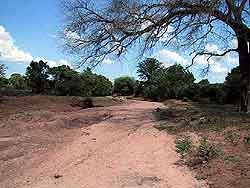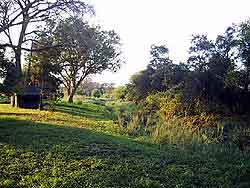by Joy Livingwell
Even a simple ecosystem is very, very complex. In order to work with nature's complexity, we can focus on the fundamental processes that operate in any ecosystem.
Allan Savory
 Poor ecosystem function. This river only runs during flash floods. Most ground is bare, so biological productivity is low and soil-building processes have stopped. Droughts and floods are the norm, and biodiversity loss is severe.
Allan Savory
 Healthier ecosystem function. This nearby river contains water year-round. Ground cover and biological productivity are much higher, and nutrients recycle faster. Flooding is less severe, drought rare, and biodiversity is increasing. Article |
4 ecosystem processes
Four basic processes at work in all ecosystems allow us to quickly gauge the health of the land:
- Water cycle: Does rain feed plants and recharge groundwater, or does it run off the land, causing erosion? Do springs and streams flow seasonally or year-round?
- Mineral cycle: Are nutrients available to living things? Or are they locked in standing dead growth, or sunk below the root zone? Do they escape when plants burn or soil washes away?
- Energy flow: How much sunlight falls on green leaves and gets turned into food for the ecosystem? How much is wasted striking dead growth or bare ground?
- Community dynamics (also called succession): Do many species have fairly stable populations of all ages? Or does the population of just a few species fluctuate widely?
These processes are sometimes called the four ecosystem foundation blocks because they are so fundamental to ecosystem function.
Modifying any one of these processes automatically changes all of them because in reality, they are only different aspects of the same thing. Think of them as four different windows through which you can observe the same room. Or imagine them as the blood, breath, organs, and nerves in your body. You cannot have a healthy liver without air to breathe, or have healthy lungs if your liver fails!
In order to have an effective water or mineral cycle, or adequate energy flow, an ecosystem must have communities of living organisms. For living things to thrive, they need effective energy flow to feed them, a water cycle that supplies adequate moisture, and a mineral cycle that supplies vital nutrients. All four processes work together to create a healthy or unhealthy ecosystem.